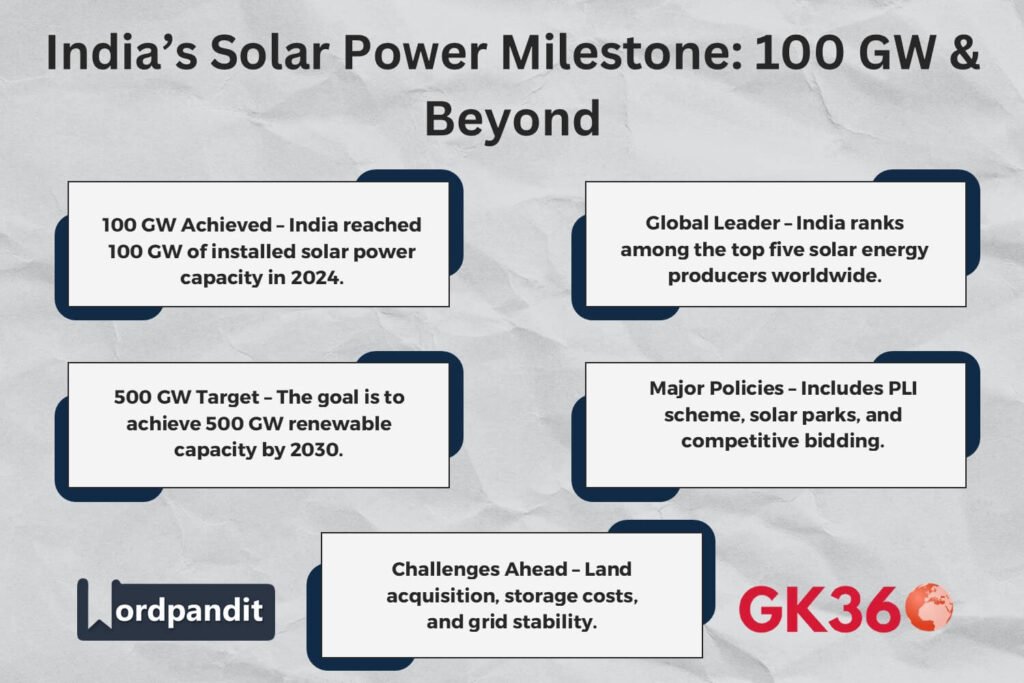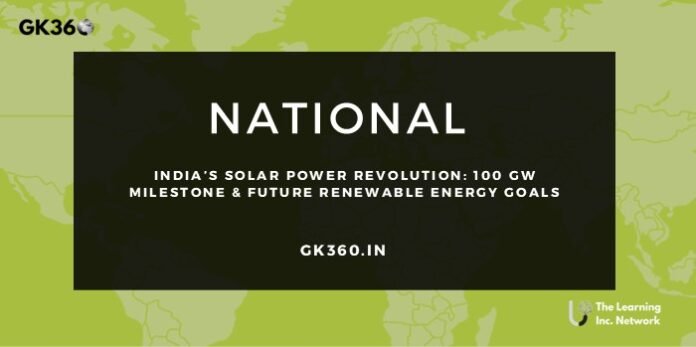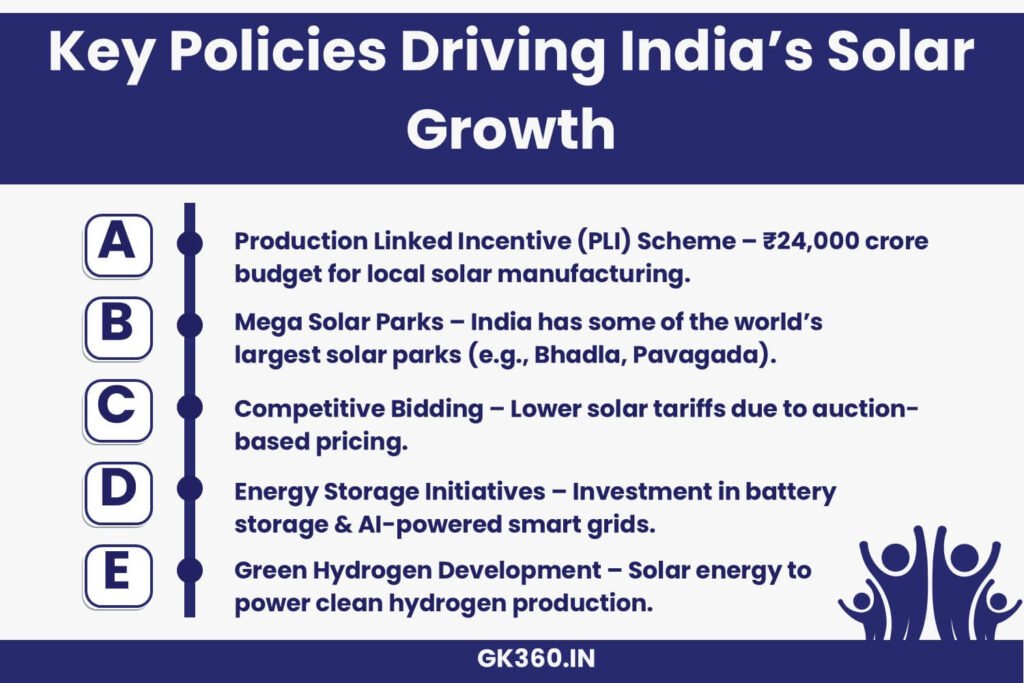India’s Solar Power Revolution: 100 GW Milestone & Future Renewable Energy Goals
Introduction
India has reached a groundbreaking achievement in its renewable energy transition by surpassing 100 gigawatts (GW) of installed solar power capacity. This milestone reinforces India’s leadership in clean energy and its commitment to reducing carbon emissions while decreasing reliance on fossil fuels.
Union Minister Pralhad Joshi announced this achievement, marking a major step toward India’s ambitious 500 GW renewable energy target by 2030. With strong government policies, investments, and global collaborations, India is accelerating its solar expansion.

Table of Contents
- India’s Solar Power Journey: From Vision to Reality
- Government Policies That Fueled Solar Growth
- India’s Future Renewable Energy Goals
- India’s Role in Global Renewable Energy Leadership
- Challenges in Achieving 500 GW Renewable Energy Target
- FAQs: Everything About India’s Solar Power Growth
- Conclusion & Call-to-Action
India’s Solar Power Journey: From Vision to Reality
India’s solar revolution began with the launch of the National Solar Mission (NSM) in 2010, which aimed to make India a global solar energy hub.
- 2014: The government set an ambitious 100 GW solar target by 2022.
- 2017: Large-scale solar parks and rooftop solar initiatives gained momentum.
- 2020: Solar power became the cheapest energy source in India.
- 2024: India crossed the 100 GW milestone, despite delays due to global supply chain disruptions and land acquisition challenges.
With solar power now accounting for a significant share of India’s renewable energy mix, the next challenge is scaling up toward the 500 GW goal by 2030.
Government Policies That Fueled Solar Growth
Production Linked Incentive (PLI) Scheme
To boost domestic solar manufacturing and reduce reliance on imported solar panels, India launched the PLI scheme with a budget of ₹24,000 crore.
- 🎯 Aim: Develop 48 GW of solar equipment manufacturing capacity by 2026.
- 💡 Impact: Encourages local production of high-efficiency photovoltaic (PV) modules and creates jobs in the clean energy sector.
Solar Parks and Large-Scale Projects
India has developed some of the world’s largest solar parks, attracting foreign and domestic investments.
🔹 Key Solar Parks:
- ☀️ Bhadla Solar Park (Rajasthan) – 2,245 MW capacity.
- ⚡ Pavagada Solar Park (Karnataka) – 2,050 MW capacity.
- 🌞 Rewa Ultra Mega Solar Park (Madhya Pradesh) – 750 MW capacity.
🔹 Future Plans:
- 🚀 Expansion of mega solar parks and floating solar projects to maximize land use.
Renewable Energy Auctions & Competitive Bidding
India’s auction-based solar policy has driven down costs and increased competition.
- 💰 Result: India has some of the lowest solar energy tariffs globally, making solar affordable.
- 📈 Benefit: Attracts private sector participation and accelerates capacity addition.
Grid Integration & Energy Storage Solutions
The biggest challenge in solar adoption is its intermittent nature—power generation depends on sunlight.
🔹 Solutions Implemented:
- 🔋 Battery Energy Storage Systems (BESS) for surplus energy storage.
- 🌐 Smart grid infrastructure to manage fluctuations.
- 🌪️ Solar-wind hybrid projects to improve reliability.
India’s Future Renewable Energy Goals
India’s next big step is achieving 500 GW of total renewable capacity by 2030, with solar playing a dominant role.
Scaling Up Infrastructure
- 🏗️ India currently has 47.49 GW of solar projects in the pipeline.
- 🏡 Expansion of rooftop solar and agrivoltaics (solar farming) to enhance distributed energy generation.
Enhancing Storage & Grid Modernization
- 🔋 Advancements in battery technology (e.g., lithium-ion, pumped hydro storage) to ensure 24/7 solar power supply.
- 🤖 Artificial Intelligence (AI)-powered grids for real-time energy demand management.
Green Hydrogen and Solar Industries
- ⚡ India aims to become a global leader in green hydrogen, using solar power to produce clean fuel.
- 🚛 Potential applications: Hydrogen-powered industries, steel production, and clean transport solutions.
India’s Role in Global Renewable Energy Leadership
India has emerged as a key player in international climate action by:
- ✅ Co-founding the International Solar Alliance (ISA) with France to promote global solar adoption.
- 🌍 Partnering with global clean energy firms to attract investments.
- 🔋 Setting an example for developing nations to transition toward renewables.
Challenges in Achieving 500 GW Renewable Energy Target
Despite progress, India faces key challenges:
- 🚧 Land Acquisition: Large solar farms require vast land, leading to disputes.
- 💰 Financing & Investment: Need for continued funding and incentives for private players.
- 🔋 Storage Costs: Advanced battery technology is still expensive.
- ⚡ Grid Stability: Need for stronger infrastructure to support high solar penetration.
India is addressing these challenges through policy reforms, foreign investments, and innovation in energy storage.
FAQs: Everything About India’s Solar Power Growth
🔹 Q1: How much solar power capacity does India have currently?
✅ As of 2024, India has 100 GW of installed solar power capacity.
🔹 Q2: What is India’s renewable energy target for 2030?
✅ India aims to achieve 500 GW of total renewable energy capacity by 2030, with a major focus on solar power.
🔹 Q3: What are the biggest solar parks in India?
- ☀️ Bhadla Solar Park – 2,245 MW (Rajasthan)
- ⚡ Pavagada Solar Park – 2,050 MW (Karnataka)
- 🌞 Rewa Ultra Mega Solar Park – 750 MW (Madhya Pradesh)
🔹 Q4: What is the role of government policies in India’s solar growth?
✅ Key policies include PLI Scheme, Solar Parks Development, Competitive Bidding, and Grid Modernization.
🔹 Q5: How does India compare to other countries in solar power?
✅ India is the fifth-largest solar energy producer globally and aims to be a top solar manufacturing hub.
Conclusion & Call-to-Action
India’s milestone of 100 GW solar capacity is a testament to its commitment to clean energy and its position as a global leader in renewable power.
With ambitious goals of 500 GW by 2030, India is investing in storage solutions, green hydrogen, and solar innovation to build a sustainable future.
Key Takeaways
| Aspect | Details |
|---|---|
| India’s Solar Achievement | 100 GW installed capacity as of 2024. |
| Renewable Energy Target | 500 GW total renewable energy capacity by 2030. |
| Major Solar Parks | Bhadla (2,245 MW), Pavagada (2,050 MW), Rewa (750 MW). |
| Key Government Policies | PLI scheme, Solar Parks, Competitive Bidding, Grid Modernization. |
| Global Ranking | India is among the top five solar energy producers worldwide. |
| Challenges | Land acquisition, financing, energy storage costs, and grid integration. |
| Future Innovations | AI-powered smart grids, battery storage, and green hydrogen production. |
Related Terms:
- India Solar Power
- 100 GW Solar Milestone
- India Renewable Energy Goals
- Solar Energy Policies India
- PLI Scheme Solar India
- India 500 GW Renewable Energy Target
- Solar Parks in India
- Green Hydrogen India
- AI in Renewable Energy
- Energy Storage & Smart Grids






